Overview
The article "10 Tips for Eating for Diabetes Type 2 Management" offers practical strategies for managing Type 2 diabetes through thoughtful dietary choices. It's understandable to feel overwhelmed, but focusing on meal timing can make a significant difference in your daily routine.
- Carbohydrate counting is another essential tool, allowing you to take control of your meals while incorporating variety to keep things interesting.
- Practicing portion control is vital, as is engaging in regular physical activity, which can uplift your spirits and improve your health.
- Staying hydrated is often overlooked, yet it plays a crucial role in your overall well-being.
- Choosing healthy fats can also contribute positively to your diet.
- Planning meals ahead of time not only eases stress but also empowers you to make healthier choices.
- Remember, you don't have to navigate this journey alone; seeking community support can provide encouragement and shared experiences that enhance your journey.
By integrating these strategies, you can work toward improved blood sugar control and overall health outcomes. You're not alone in this journey; we are here to support you every step of the way.
Introduction
In the journey of managing Type 2 Diabetes, knowledge and support are truly essential. T2DSolutions emerges as a vital resource, offering a wealth of educational tools and opportunities for community engagement that empower individuals on their health journey. From personalized meal plans to exercise routines and the latest medical insights, this comprehensive platform ensures that users have access to the information they need for effective diabetes management.
With a focus on practical strategies such as:
- Meal timing
- Carbohydrate counting
- Portion control
T2DSolutions not only promotes better health outcomes but also nurtures a sense of community where shared experiences and encouragement thrive. It’s understandable to feel overwhelmed at times, but as you navigate the complexities of diabetes, T2DSolutions serves as a guiding light, illuminating the path towards a healthier, more informed lifestyle. Remember, you’re not alone in this journey; we are here to support you every step of the way.
T2DSolutions: Your Comprehensive Resource for Type 2 Diabetes Management
At T2DSolutions, we understand that managing Type 2 Diabetes can feel overwhelming, and we are here to empower you on this journey. Our platform offers a wealth of educational resources and support tailored just for you. With customized dietary plans, workout regimens, and the latest medical research at your fingertips, you have access to vital tools for effective management of your condition.
We recognize how important community engagement is during this time. That's why T2DSolutions fosters a supportive environment where you can share your experiences and find encouragement from others who understand what you're going through. You're not alone in this journey; together, we can enhance your path through diabetes.
This holistic approach not only improves your understanding but also nurtures resilience, ultimately leading to better health outcomes. Remember, we are here to support you every step of the way. Take the first step today by exploring our resources and connecting with our community.
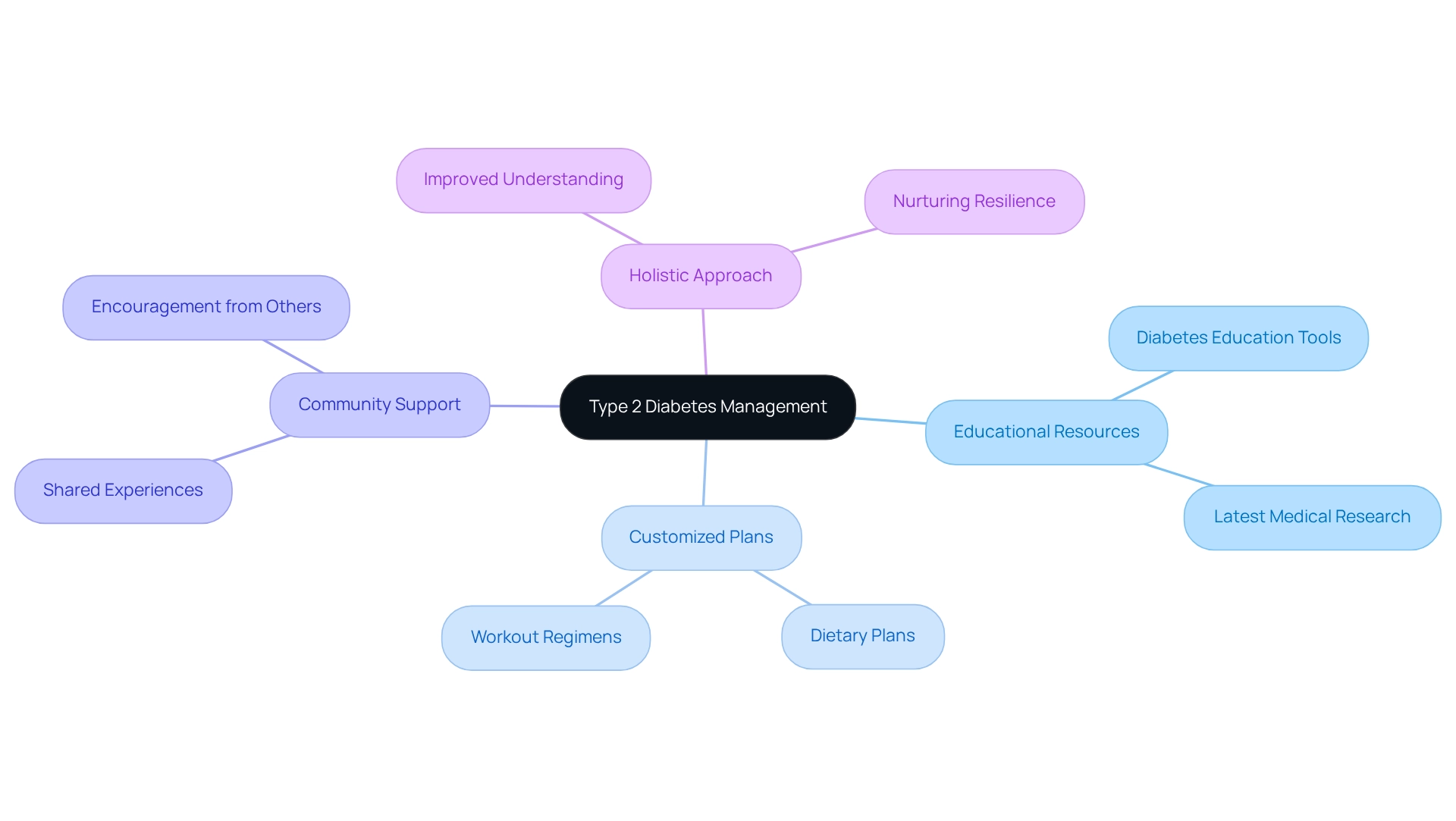
Prioritize Meal Timing: Regulate Blood Sugar Effectively
Establishing a consistent eating schedule is crucial for effectively regulating your blood sugar levels when eating for diabetes type 2. Aim to enjoy your meals at the same times each day, spacing them about 4-6 hours apart. This routine allows your body to anticipate food intake, leading to more stable blood glucose levels. It's understandable to feel overwhelmed, but research indicates that practicing mindful eating can further enhance this stability, helping you avoid overeating and promoting healthier food choices.
Incorporating healthy snacks can also be beneficial, especially when they are balanced and portion-controlled. For instance, popcorn can serve as a nutritious snack option when prepared mindfully. A study by Imai S et al. highlighted the advantages of evening snacking, revealing that a 75-calorie snack consumed after dinner significantly reduced glycemic excursion amplitude and postprandial serum glucose levels. This shows that strategic food timing, including snacks, plays a vital role in managing blood sugar.
Nutritionists emphasize the importance of regular eating times, noting that it not only aids in blood sugar control, which is essential when considering eating for diabetes type 2, but also supports your overall metabolic well-being. You're not alone in this journey; T2DSolutions seeks to offer resources and assistance for individuals looking to develop effective meal routines. By following a structured eating schedule that emphasizes eating for diabetes type 2, you can better manage your condition and enhance your quality of life. Consider monitoring your eating patterns to ensure consistency and support your blood sugar control efforts.
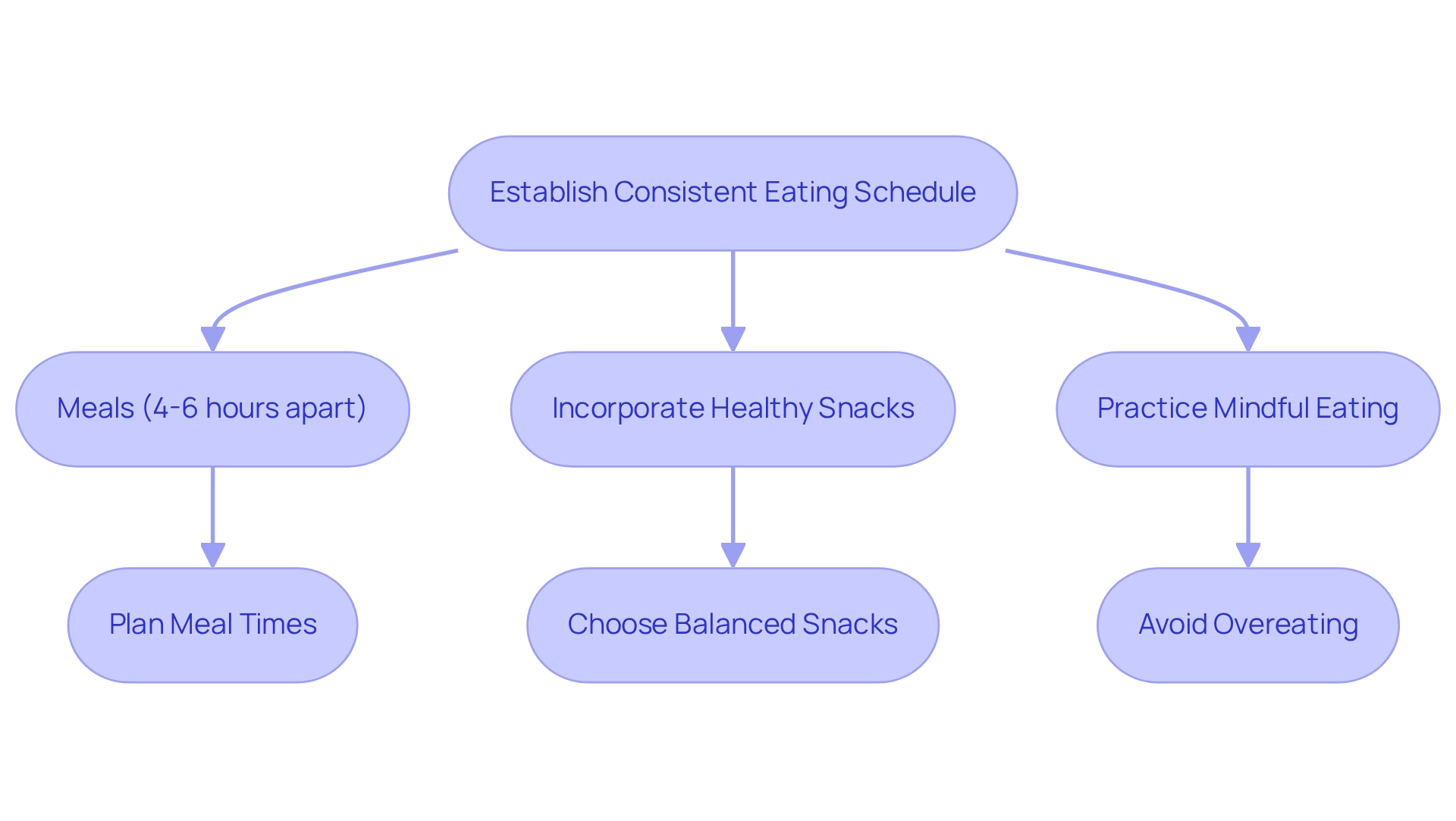
Count Carbohydrates: Control Your Intake for Better Management
Counting carbohydrates is essential when eating for diabetes type 2 to ensure effective control. Aiming for a consistent carbohydrate intake at each meal is important when eating for diabetes type 2, as it can significantly stabilize blood sugar levels, reducing the risk of spikes and dips. Research indicates that over 40 years of empirical testing, involving more than 85,000 tests, has demonstrated a direct correlation between carbohydrate consumption and weight control, which is crucial for effective eating for diabetes type 2.
As T2DSolutions launches as a new resource hub for education on managing health, it provides valuable tools and information to assist you in managing your carbohydrate intake. To efficiently monitor your carbohydrate consumption while eating for diabetes type 2, consider utilizing resources like food labels and mobile applications designed for managing blood sugar. These tools can simplify the process, making it easier for you to track your daily intake. Additionally, consulting with a healthcare provider can help determine the appropriate carbohydrate amounts for eating for diabetes type 2, tailored to your individual needs.
It's important to recognize common signs of diabetes, such as polydipsia, polyuria, and polyphagia, as these can highlight the necessity of managing carbohydrate intake while eating for diabetes type 2. Recent studies, including the ADMIRE study, which investigated the effectiveness of Dapagliflozin and Metformin as initial therapy for Type 2 Diabetes, emphasize the value of structured dietary approaches, particularly eating for diabetes type 2, including carbohydrate counting, in improving glycemic control and patient adherence. This method not only assists in managing blood sugar levels but also encourages a proactive approach to eating for diabetes type 2.
Incorporating expert insights, dietitians stress that with practice and support, eating for diabetes type 2 can seamlessly integrate carbohydrate counting into your daily routine, empowering you to lead a healthier life. Wil Dubois observes, "With practice and assistance, carb counting can turn into a simple and efficient component of your daily routine, aiding you in leading a healthier life with blood sugar management." Effective carbohydrate monitoring techniques, such as food preparation and portion control, can further enhance blood sugar regulation, which is crucial when eating for diabetes type 2, ensuring that you stay informed and involved in your dietary choices.
To reinforce your learning about eating for diabetes type 2, consider setting a daily carbohydrate goal and tracking your intake to understand how it affects your blood sugar levels. For additional resources and assistance, visit T2DSolutions to explore tools and tips customized for your diabetes management journey. Remember, you're not alone in this journey; we are here to support you every step of the way.
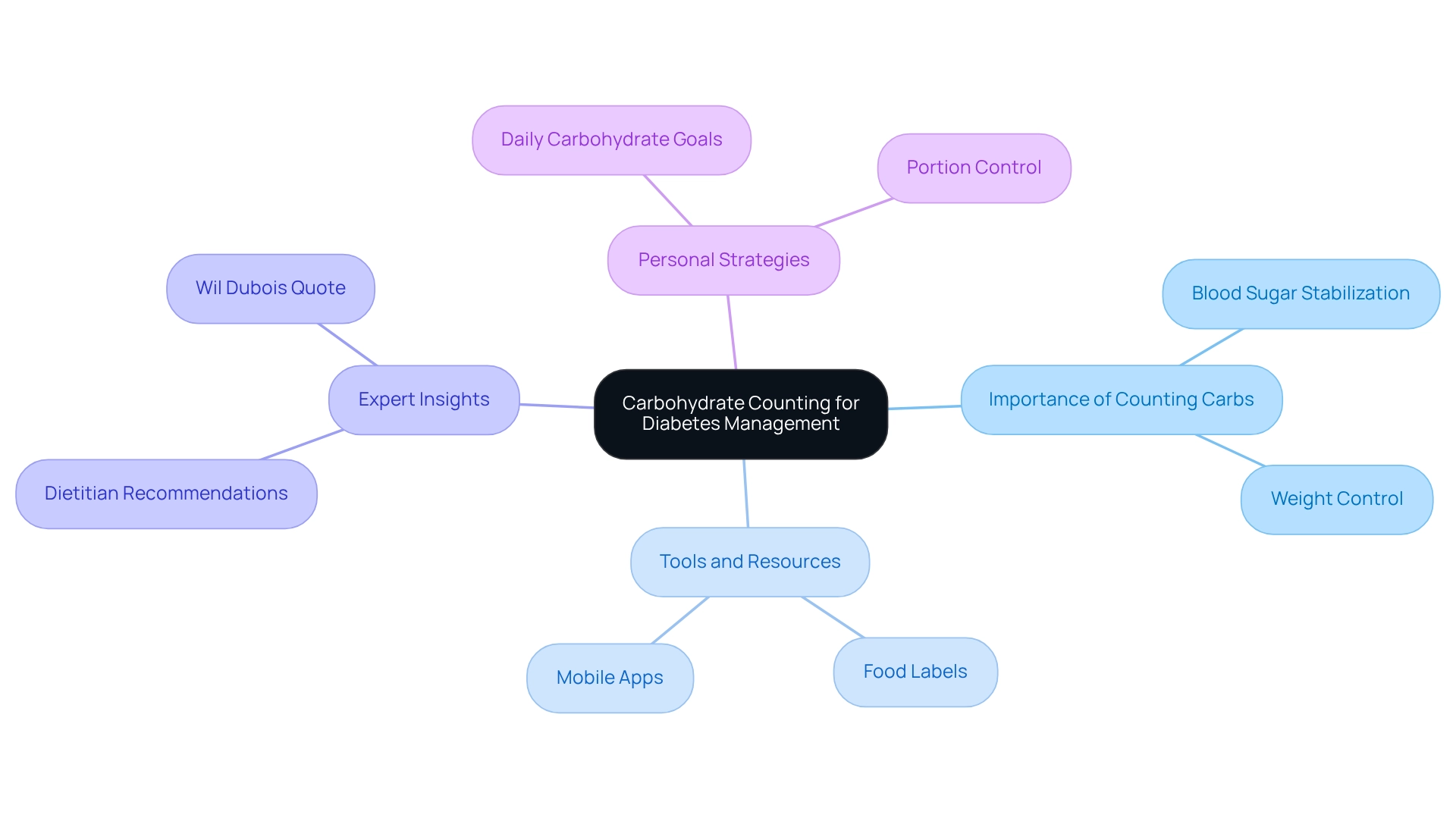
Incorporate Variety: Ensure a Balanced Diet for Optimal Health
Incorporating a variety of foods into your diet is a nurturing step toward ensuring you receive essential nutrients. It's understandable to feel overwhelmed by dietary choices, but focusing on including different:
- Fruits
- Vegetables
- Whole grains
- Lean proteins
- Healthy fats
can make a significant difference. This variety not only promotes your overall health but also helps to avoid dietary monotony. By embracing these diverse options, you can find it simpler to adhere to your eating plan and feel more satisfied in your journey. Remember, you're not alone in this journey; we are here to support you every step of the way.

Practice Portion Control: Manage Your Food Intake Wisely
Effective portion control is crucial when it comes to eating for diabetes type 2, as it directly influences blood sugar levels and overall health. One practical strategy to consider is using smaller plates. This simple change can help visually reduce serving sizes and prevent overeating, making mealtime feel less overwhelming. Familiarizing yourself with standard portion sizes for various food groups is essential. For instance, a single teaspoon is roughly the size of your fingertip; this can serve as a handy reference for measuring condiments and spreads.
Utilizing measuring cups or a food scale can further enhance accuracy in portion sizes, ensuring that you are consuming the right amounts of food. Aim to fill half your plate with non-starchy vegetables. These are low in calories and high in nutrients, providing a satisfying and healthy base for your dishes.
Recent studies have shown that participants who engaged in portion control strategies, such as those in the portioned meal box (PMB) group, reported higher satisfaction levels. They were more likely to recommend these approaches to others. This suggests a favorable response to organized portion control techniques among individuals managing diabetes-related issues.
Dietitians emphasize the significant impact of portion sizes on blood sugar levels when it comes to eating for diabetes type 2. Even small adjustments can lead to better glycemic control, which is encouraging to know. T2DSolutions is dedicated to assisting individuals in their healthcare journey by offering valuable resources and community assistance. By implementing these effective portion control techniques and seeking support from healthcare experts and your community, you can take proactive steps toward successful health maintenance, particularly with regard to eating for diabetes type 2. Remember, living with this condition can be a journey of growth and self-care. You’re not alone in this journey; we are here to support you every step of the way. Together, we can enhance your quality of life and foster a healthier relationship with food.

Engage in Regular Physical Activity: Boost Your Health
Engaging in regular physical activity is a wonderful way to support your health, especially when it comes to managing blood sugar levels and improving insulin sensitivity. Aim for at least 150 minutes of moderate aerobic exercise each week—activities like brisk walking, swimming, or cycling can be enjoyable and beneficial. Remember, incorporating strength training exercises at least twice a week can significantly enhance your muscle mass and metabolic health.
It's understandable to feel overwhelmed when starting a new routine, but know that you're not alone in this journey. Many have found success by gradually introducing these activities into their lives. Consider seeking support from friends or joining a community group where you can share experiences and encouragement.
Taking these steps can not only improve your physical well-being but also foster a sense of connection and motivation. You're doing great by taking the time to learn about your health, and we are here to support you every step of the way.

Stay Hydrated: Support Your Body's Functions
Maintaining hydration is essential for effectively managing your condition. Aim to drink at least 8 cups of water each day, and feel free to adjust this based on your activity level and the climate you’re in. Staying well-hydrated not only helps regulate blood sugar levels but also supports kidney function, which is particularly important for those with diabetes-related conditions. It's understandable to feel overwhelmed, but research shows that dehydration can lead to higher blood sugar levels, making it crucial to keep your fluid intake in check.
If you're looking to make hydration more enjoyable, consider infusing your water with fruits or herbs. This can provide a flavorful alternative without added sugars, making it easier to drink the amount you need. By prioritizing hydration, you empower your body to function optimally and manage blood sugar levels more effectively. Remember, you're not alone in this journey, and small steps like this can make a significant difference.
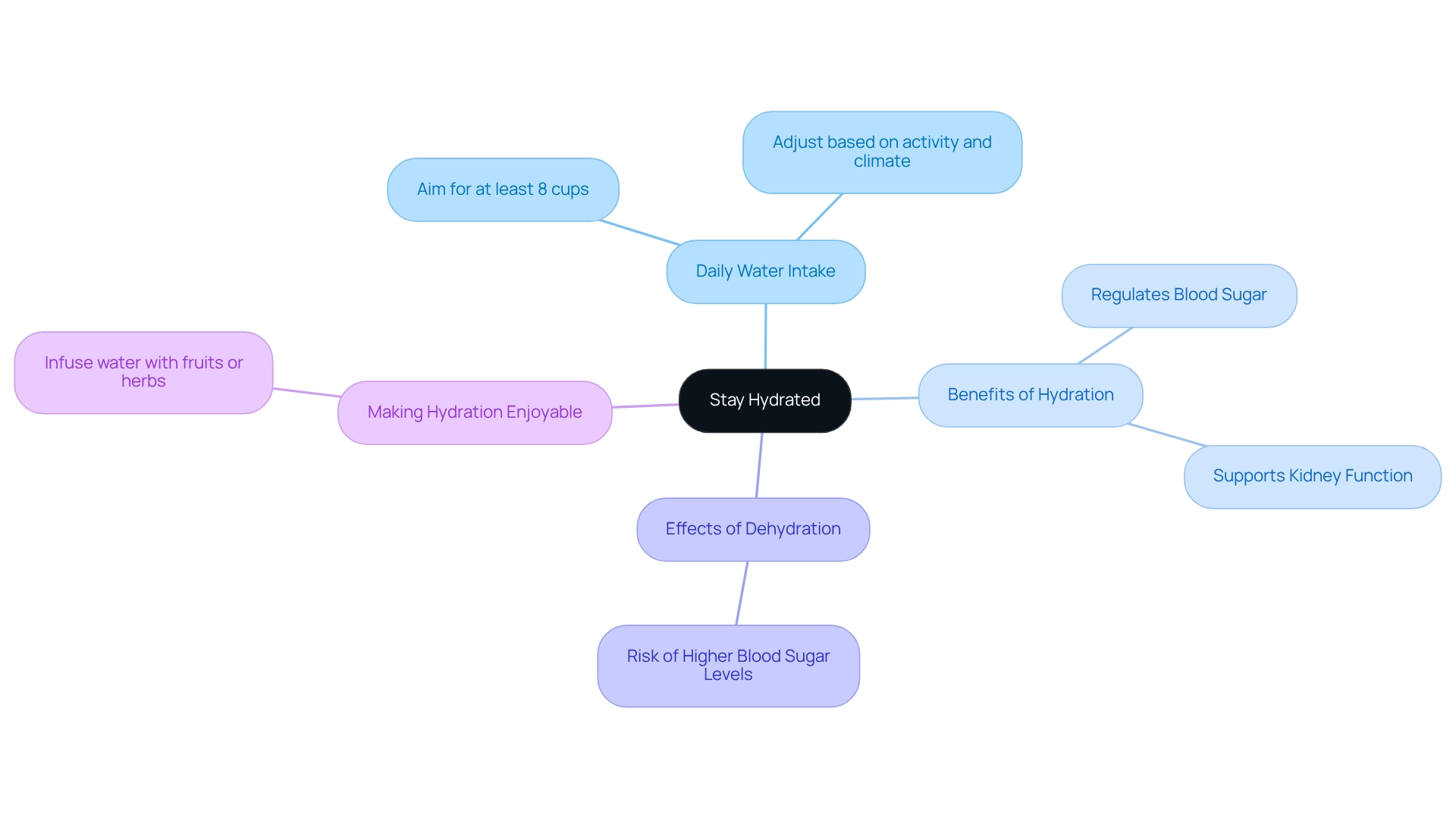
Choose Healthy Fats: Enhance Your Diet for Better Control
Incorporating healthy fats into your diet is essential for supporting heart health and enhancing blood sugar control. It's understandable to feel overwhelmed when navigating dietary choices, but focusing on unsaturated fats can make a significant difference. These beneficial fats can be found in foods like avocados, nuts, seeds, and olive oil. Not only do they enhance overall well-being, but they also play a vital role in managing blood sugar levels effectively. Research shows that diets high in unsaturated fats can lead to better blood sugar levels, making them a valuable addition to your dietary plan.
On the other hand, it's important to be mindful of saturated and trans fats, often lurking in processed foods and fatty cuts of meat. These can negatively impact heart health and complicate blood sugar control. Nutritionists emphasize that making informed choices about dietary fats can significantly influence your blood sugar management. A study even highlighted the positive effects of healthy fats on glycemic response, reinforcing the idea that your diet is like a bank account—good food choices are wise investments.
Effective strategies for controlling dietary fat involve incorporating a variety of unsaturated fats into your meals and snacks. For instance, consider enjoying a small serving of reduced-fat natural yogurt with fruit as a nutritious between-meal snack. This option provides both healthy fats and essential nutrients. By understanding the function of dietary fats and making intentional decisions, you can make meaningful progress toward improved management of blood sugar levels, which is essential for eating for diabetes type 2.
To further support your journey, explore T2DSolutions, a new resource hub dedicated to education and community support for managing health. You're not alone in this journey—stay informed and empowered by subscribing for updates and tips on managing your diabetes effectively.
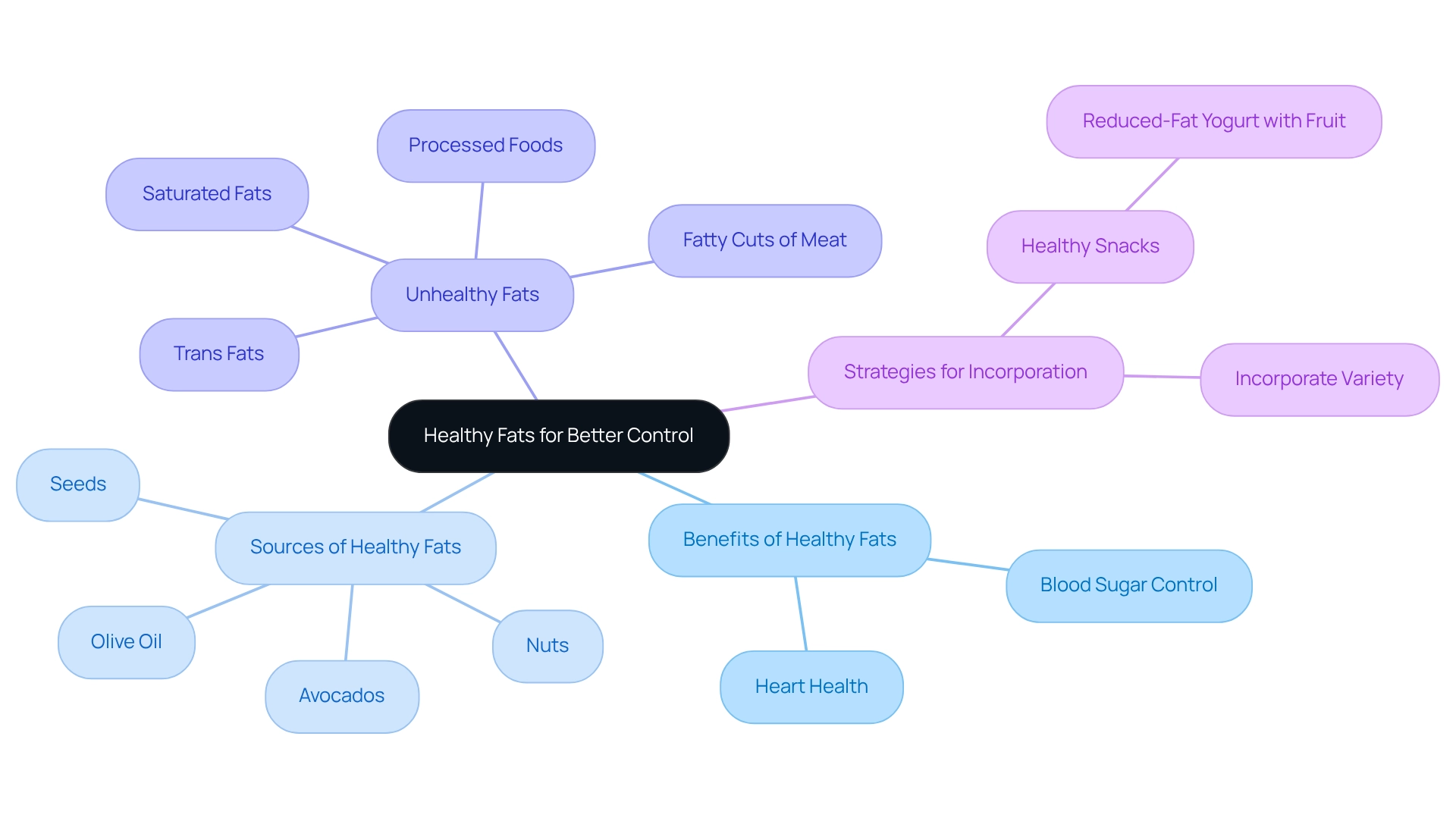
Plan Your Meals: Simplify Healthy Eating Choices
Organizing your food in advance is a compassionate approach to simplifying healthy eating and achieving your dietary goals. By dedicating time each week to develop a thorough food plan that includes a variety of nutritious items, you can significantly improve your overall health. Start by creating a shopping list based on your dining plan; this can help reduce impulse buys that may disrupt your efforts. Batch cooking is another effective technique; it not only saves time during the week but also ensures you have healthy options readily available.
It's understandable to feel overwhelmed, but statistics show that many individuals with Type 2 Diabetes can effectively manage their blood glucose levels by focusing on eating for diabetes type 2, along with a balanced dietary plan, regular physical activity, and appropriate medications. This highlights the importance of food planning as a cornerstone of eating for diabetes type 2 management. T2DSolutions offers valuable resources and guidance to assist you in developing effective dietary plans tailored to your unique needs.
To create an effective meal plan, consider these strategies:
- Incorporate a mix of food groups to ensure a well-rounded diet.
- Focus on portion control, especially when dining with others; providing individual portions can enhance food safety and hygiene.
- Stay updated on the latest dietary recommendations and tips for 2025 to keep your food planning relevant and effective.
Nutritionists emphasize the benefits of food preparation for individuals managing blood sugar challenges, noting that it can lead to better adherence to dietary recommendations and improved health outcomes. By focusing on personalized nutritional guidance, particularly for special populations like older adults, you can help mitigate health risks associated with poor dietary choices. T2DSolutions provides insights and assistance specifically designed for these groups.
Integrating these dietary planning techniques not only supports effective blood sugar management essential for eating for diabetes type 2 but also encourages a healthier lifestyle overall. Remember, successful food planning is about making informed choices that align with your health goals. You're not alone in this journey—explore T2DSolutions for additional resources and support in your meal planning efforts. Together, we can work towards addressing the growing health crisis related to diabetes.
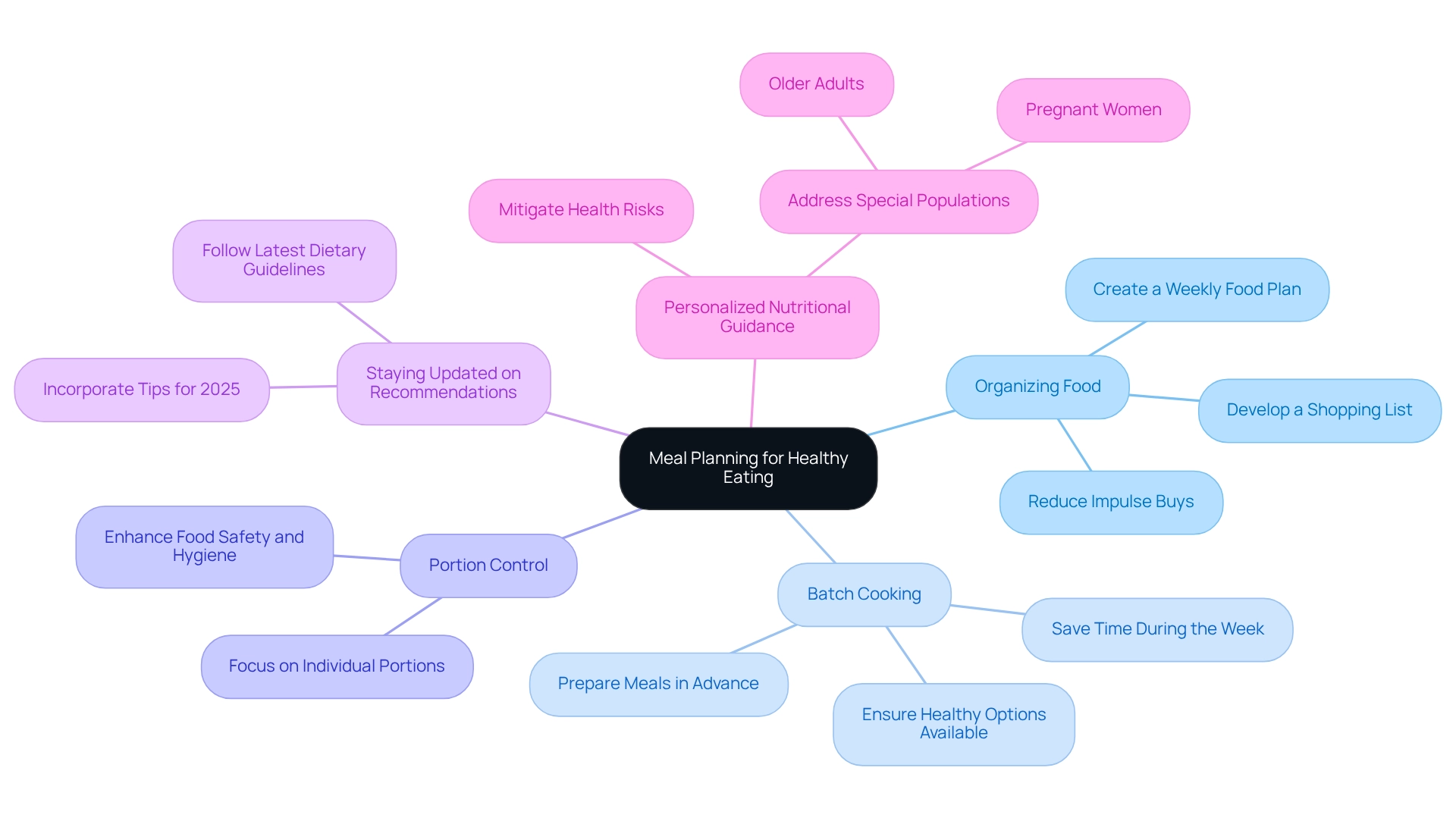
Seek Support: Connect with Resources and Community
Engaging with support groups and resources can offer invaluable help in managing your condition. It’s understandable to feel overwhelmed, but seeking out local or online communities can provide a safe space to share experiences, ask questions, and receive encouragement. You're not alone in this journey—many have walked this path and found solace in connection.
T2DSolutions is dedicated to being your comprehensive resource for Type 2 and Type 3 diabetes management. We offer various resources, including educational materials and forums, to help you connect with others who are facing similar challenges. Remember, we are here to support you every step of the way. Take that first step towards finding the community that can uplift you.
Conclusion
Managing Type 2 Diabetes can feel overwhelming at times, but remember, with the right resources and support, you can truly thrive. T2DSolutions is here as a vital ally, offering comprehensive tools designed to empower you to take charge of your health. By establishing consistent meal timing, mastering carbohydrate counting, and implementing effective portion control, you can equip yourself with practical strategies that significantly improve blood sugar management.
In addition, engaging in regular physical activity, staying hydrated, and incorporating healthy fats into your diet are essential components that enhance your overall well-being. By planning meals and seeking community support, you can navigate the complexities of diabetes with greater confidence and resilience. T2DSolutions fosters a sense of belonging, reminding you that you are not alone in this journey.
Ultimately, the combination of education, community engagement, and personalized strategies provided by T2DSolutions creates a powerful framework for successful diabetes management. Embracing these resources not only promotes better health outcomes but also cultivates a proactive approach to living well with diabetes. Taking small, informed steps can lead to a healthier, more fulfilling lifestyle, making it clear that effective diabetes management is within reach for everyone. You're not alone in this journey, and support is available every step of the way.
Frequently Asked Questions
What is T2DSolutions?
T2DSolutions is a comprehensive resource platform designed to support individuals in managing Type 2 Diabetes by providing educational resources, customized dietary plans, workout regimens, and access to the latest medical research.
How does T2DSolutions support community engagement?
T2DSolutions fosters a supportive environment where users can share experiences and find encouragement from others who understand the challenges of managing Type 2 Diabetes, emphasizing that individuals are not alone in their journey.
Why is meal timing important for managing Type 2 Diabetes?
Establishing a consistent eating schedule helps regulate blood sugar levels by allowing the body to anticipate food intake, leading to more stable glucose levels. Meals should be spaced about 4-6 hours apart.
How can mindful eating help with blood sugar management?
Practicing mindful eating can enhance blood sugar stability, helping individuals avoid overeating and make healthier food choices, which is particularly beneficial for managing Type 2 Diabetes.
What role do snacks play in blood sugar control?
Healthy, balanced, and portion-controlled snacks can be beneficial for managing blood sugar levels. For example, a 75-calorie snack consumed after dinner can help reduce glycemic excursion and postprandial glucose levels.
Why is counting carbohydrates crucial for individuals with Type 2 Diabetes?
Counting carbohydrates is essential for stabilizing blood sugar levels and reducing the risk of spikes and dips. A consistent carbohydrate intake at each meal can significantly improve glycemic control.
What tools can help with monitoring carbohydrate intake?
Resources such as food labels and mobile applications designed for blood sugar management can simplify the process of tracking carbohydrate consumption.
How can consulting with a healthcare provider assist in managing carbohydrate intake?
A healthcare provider can help determine the appropriate carbohydrate amounts tailored to individual needs, which is vital for effective management of Type 2 Diabetes.
What are common signs of diabetes that highlight the need for carbohydrate management?
Common signs of diabetes include polydipsia (excessive thirst), polyuria (frequent urination), and polyphagia (increased hunger), which indicate the necessity of managing carbohydrate intake.
What is the significance of the ADMIRE study mentioned in the article?
The ADMIRE study investigated the effectiveness of Dapagliflozin and Metformin as initial therapy for Type 2 Diabetes and emphasized the value of structured dietary approaches, including carbohydrate counting, in improving glycemic control and patient adherence.
How can individuals effectively integrate carbohydrate counting into their routine?
With practice and support, individuals can seamlessly incorporate carbohydrate counting into their daily routine, aiding in blood sugar management and leading a healthier life.
What resources does T2DSolutions offer for individuals managing Type 2 Diabetes?
T2DSolutions provides tools and tips customized for diabetes management, including dietary plans, educational resources, and community support to help individuals navigate their journey with Type 2 Diabetes.



